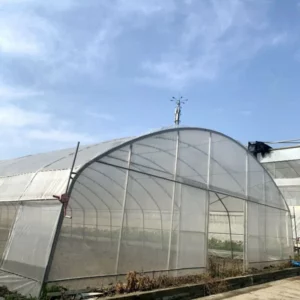Greenhouse plastic film is a versatile and widely used material in modern agriculture, providing an effective solution for creating controlled environments for plant cultivation. Understanding the composition and characteristics of greenhouse plastic film is essential for growers seeking to optimize their greenhouse operations. In this article, we will delve into the materials commonly used to manufacture greenhouse plastic film and explore the key characteristics that make it a preferred choice for growers worldwide.
I. Polyethylene (PE) – The Primary Material
- High Density Polyethylene (HDPE):
High Density Polyethylene is a commonly used type of polyethylene in the production of greenhouse plastic film. HDPE is renowned for its excellent strength, tear resistance, and durability. It offers superior puncture resistance, protecting the film from accidental damage during installation or everyday greenhouse activities. HDPE greenhouse film is known for its longevity and ability to withstand harsh weather conditions. - Low Density Polyethylene (LDPE):
Low Density Polyethylene is another type of polyethylene used in greenhouse film manufacturing. LDPE possesses excellent flexibility and is highly resistant to chemicals, making it suitable for applications requiring a more elastic and conformable film. LDPE greenhouse film provides good light transmission and is often used in structures that require a higher degree of flexibility, such as hoop houses or tunnels.
II. Polyvinyl Chloride (PVC)
Polyvinyl Chloride is occasionally used in greenhouse plastic film production. PVC films offer good light transmission and have excellent fire-retardant properties. However, compared to polyethylene films, PVC films are less commonly used due to their higher cost and lower durability. PVC films are generally employed in specialized applications where their unique properties are advantageous, such as in greenhouses with specific temperature or fire safety requirements.
III. Coatings and Additives
- Ultraviolet (UV) Stabilizers:
To enhance the longevity of greenhouse plastic film, UV stabilizers are added during the manufacturing process. These additives absorb or reflect harmful UV radiation, preventing the degradation of the film due to prolonged exposure to sunlight. UV stabilizers extend the lifespan of the film, ensuring it remains intact and effective in protecting plants. - Anti-Fogging Agents:
Greenhouse plastic film can be treated with anti-fogging agents to minimize the formation of condensation droplets on the film’s surface. These agents alter the surface tension of the film, allowing water to spread evenly as a thin film, rather than forming droplets that obstruct light transmission. Anti-fogging agents improve light distribution and reduce the risk of water droplets falling onto plants, preventing potential damage or disease. - Light Diffusion Additives:
Some greenhouse plastic films incorporate light diffusion additives that scatter sunlight, creating a more uniform distribution of light within the greenhouse. This diffusion helps minimize shadows and hot spots, ensuring that plants receive an even amount of light across their canopies. Light diffusion additives optimize photosynthesis and promote balanced plant growth.
IV. Key Characteristics
- Light Transmission:
Greenhouse plastic film is designed to allow a specific range of light wavelengths to pass through, promoting photosynthesis and plant growth. The light transmission properties of the film can vary depending on the type of plastic used and any additional coatings or additives applied. Optimal light transmission helps maximize crop productivity and quality. - Thermal Insulation:
Greenhouse plastic film acts as an insulator, trapping heat within the structure and protecting plants from external temperature fluctuations. The film’s thermal insulation properties contribute to maintaining stable temperatures, particularly during colder seasons or in regions with variable climates. This insulation is crucial for creating an environment conducive to plant growth. - Durability and Weather Resistance:
Greenhouse plastic film is designed to withstand harsh weather conditions, including exposure to UV radiation, wind, hail, and temperature extremes. The film’s durability ensures its long lifespan, reducing the need for frequent replacements. Weather-resistant greenhouse plastic film provides growers with a reliable and cost-effective solution for protecting their crops.
Greenhouse plastic film, primarily composed of polyethylene, serves as a vital component in modern agriculture. Its composition, including high-density or low-density polyethylene, greenhouse film plastic along with the incorporation of additives and coatings, contributes to its unique characteristics. With its excellent light transmission, thermal insulation, durability, and weather resistance, greenhouse plastic film provides growers with an effective means to create controlled environments that promote optimal plant growth and maximize crop yields.
